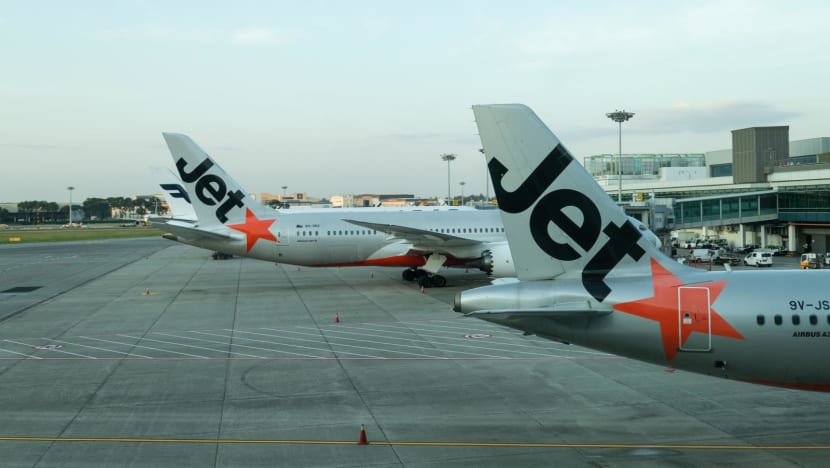Commentary: Will demise of Jetstar Asia have impact on Singapore aviation?
While Jetstar Asia’s exit is disappointing for Changi Airport Group, its small post-pandemic market share means the void it leaves should be easy to fill, says aviation analyst Brendan Sobie.

Jetstar planes on the tarmac at Changi Airport in Singapore on Sep 23, 2018. (Photo: iStock)

This audio is generated by an AI tool.
SINGAPORE: When Jetstar Asia ceases operations on Jul 31, it will mark the end of a fruitful 20-year era in Singapore’s airline sector.
Changi Airport traffic has more than doubled since Jetstar Asia launched in 2004, with low-cost carriers accounting for about 60 percent of the growth.
Jetstar Asia’s upcoming exit will once again leave the Singapore Airlines Group (SIA Group) as the only local competitor based in Changi Airport, a status it had until May 2004 when Valuair commenced operations. Jetstar Asia launched in December 2004 and acquired Valuair in July 2005.
Jetstar Asia played an important part in Singapore’s aviation history, but its role has been steadily diminishing over the last decade. Its market share in Singapore peaked at over 7 per cent in the mid-2010s, when it flew almost 4 million passengers per annum with a fleet of 18 aircraft.
Prior to the pandemic, Jetstar Asia’s market share in Singapore slipped to about 6 per cent, still operating 18 aircraft in a bigger overall market. In 2024, its market share was only 3.4 per cent with 2.3 million passengers and a downsized fleet of 13 aircraft at the end of the year.
Jetstar Asia operated 24 routes from Singapore prior to the pandemic, compared to 16 last month ahead of its planned closure.
JETSTAR ASIA LEAVES A VOID THAT CAN BE FILLED
While Jetstar Asia’s exit is disappointing for Changi Airport Group, its small post-pandemic market share means the void it leaves should be relatively easy to fill.
SIA Group, including budget subsidiary Scoot, has already announced it will pick up two of Jetstar Asia’s four exclusive routes – Okinawa and Labuan Bajo. It also plans to add flights on 10 of Jetstar Asia’s 12 competitive routes.
The only Jetstar Asia routes SIA Group is so far not stepping up are the exclusive routes of Broome and Wuxi and the competitive routes of Kuala Lumpur and Krabi. Broome and Wuxi benefitted from local government financial support. Kuala Lumpur is generally considered oversupplied and Krabi is a small route already dominated by Scoot.
Based on OAG data, over 75 per cent of Jetstar Asia’s capacity was on six highly competitive routes: Bali, Bangkok, Kuala Lumpur, Manila, Jakarta and Phuket. These were the only routes that Jetstar Asia had more than one flight per day – ranging from to two to four depending on the route and time of year.
In 2024, Kuala Lumpur, Bangkok, Jakarta and Bali were Changi’s four largest routes based on passenger traffic. Manila took the sixth spot, and Phuket narrowly missed the top 10.
Air fares across all these routes remain low in August despite Jetstar Asia’s exit, an early indication that Jetstar Asia’s demise may not have a significant impact on consumers.
For example, in the first week of August, there are several flights available for S$100 or less including taxes from Singapore to Bangkok, Jakarta, Kuala Lumpur and Phuket.
Manila and Bali are a bit more expensive with one-way fares starting at about S$120 and S$150 in early August, but for Bali there are cheaper options later in the month with fares starting at $108.
The base air fares are in many cases just a few dollars, after factoring in the S$65 in taxes and fees charged for every passenger departing Changi.
These are the kind of fares that prompted Jetstar Asia to throw in the towel and move the 13 aircraft to sister airlines in Australia and New Zealand, where average fares on similar short-haul routes are much higher.
Jetstar Asia cited intense competition and high airport fees in deciding to suspend operations. It was losing about US$2 million per month and did not see any prospect of improving yields to sufficiently cover the massive jump in costs post-pandemic – both from airports and suppliers.
SIA GROUP ENJOYS ECONOMIES OF SCALE
While SIA Group faces similar challenges, it enjoys economies of scale that Jetstar Asia never had given its small size.
SIA Group also sees much more network traffic – passengers that transfer at Changi to other flights and pay only S$12 in taxes and fees.
Transit now accounts for about half of SIA Group’s traffic, and this has been its fast-growing market segment post-pandemic. For Jetstar Asia, it only accounted for about 15 per cent.
SIA Group’s market share in Singapore has risen post-pandemic, driven primarily by gains in transit traffic, and will inevitably increase further.
While the lack of competition from other local players may seem concerning for consumers, the reality is a larger SIA Group is the only reasonable option for Changi Airport Group to achieve its growth targets and justify the investment in Terminal 5. The new terminal will increase Changi’s capacity from 90 million to 140 million passengers per annum from the mid 2030s.
Changi handled 68 million passengers last year with SIA Group, accounting for over 38 million or about 56 per cent. Transit-driven growth could result in SIA Group reaching or even exceeding 50 million annual passengers by the time T5 opens, making it likely that Scoot remains in the existing terminals given T5’s capacity is 50 million.
In addition to quickly taking over Jetstar Asia routes and airport slots, SIA Group has stated it will hire retrenched employees, including 100 pilots and 200 cabin crew.
SIA Group will likely have excess staff for at least a few months as fleet and overall capacity expansion takes place gradually. This will result in slight temporary cuts on other routes to accommodate the increases in Jetstar Asia routes. However, taking on most Jetstar Asia pilots and crew is a sensible move given current manpower challenges in Singapore.
AIRASIA CONSIDERS ITS OPTIONS
AirAsia also offered to take over Jetstar Asia’s employees and air operators’ certificate (AOC), which would have enabled the Malaysia-based airline group to set up a base in Singapore.
AirAsia last year lamented that it had applied unsuccessfully three times for a new AOC. The last new passenger airline AOC was awarded to Scoot in 2012, which merged with Tiger in 2017. Tiger launched in 2004 with SIA Group initially holding a passive minority stake and AirAsia also began serving Singapore in 2004.
While AirAsia’s latest offer to set up a base in Singapore using Jetstar Asia employees may seem attractive, SIA is a much more stable option for both employees and consumers. And if AirAsia wants to fill the void left by Jetstar Asia, it can expand in Singapore using its existing AOCs in Malaysia, Indonesia, Thailand and Philippines. These four markets account for about 95 per cent of Jetstar Asia’s capacity.
AirAsia was already larger than Jetstar Asia in Singapore despite not having a local base or AOC. However, it has been cutting capacity in Singapore over the last two years, also citing high airport charges, and has been planning further cuts as part of a strategic shift towards expanding at Senai Airport in Johor.
AirAsia has taken to social media to promote bus connections from Singapore to Senai, as the latter has much cheaper airport charges. It is not an easy sell given the inconvenience of crossing the land border, and is unlikely to work if fares across most Jetstar Asia routes remain low following its exit.
Jetstar Asia built up a strong brand in Singapore in its nearly 21 years. While it will be a sad moment when its final flight lands at Changi, our aviation market will move on without much impact.
Brendan Sobie is the founder of Singapore-based independent aviation consulting and analysis firm Sobie Aviation.













